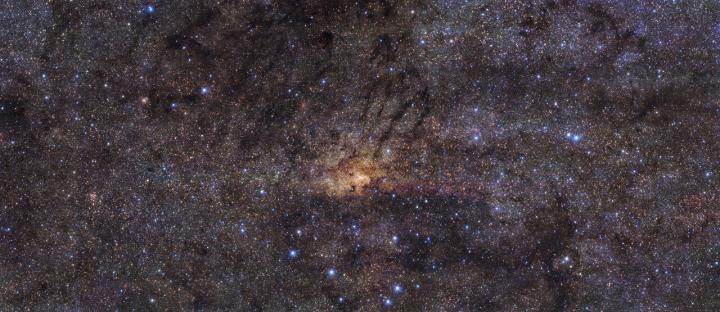ESO’s Very Large Telescope (VLT) has observed the central part of the Milky Way with spectacular resolution and uncovered new details about the history of star birth in our galaxy. Thanks to the new observations, astronomers have found evidence for a dramatic event in the life of the Milky Way: a burst of star formation so intense that it resulted in over a hundred thousand supernova explosions.
“Our unprecedented survey of a large part of the Galactic centre has given us detailed insights into the formation process of stars in this region of the Milky Way,” says Rainer Schödel from the Institute of Astrophysics of Andalusia in Granada, Spain, who led the observations. “Contrary to what had been accepted up to now, we found that the formation of stars has not been continuous,” adds Francisco Nogueras-Lara, who led two new studies of the Milky Way central region while at the same institute in Granada.
In the study, published today in Nature Astronomy, the team found that about 80% of the stars in the Milky Way central region formed in the earliest years of our galaxy, between eight and 13.5 billion years ago. This initial period of star formation was followed by about six billion years during which very few stars were born. This was brought to an end by an intense burst of star formation around one billion years ago when, over a period of less than 100 million years, stars with a combined mass possibly as high as a few tens of million Suns formed in this central region.
“The conditions in the studied region during this burst of activity must have resembled those in ‘starburst’ galaxies, which form stars at rates of more than 100 solar masses per year,” says Nogueras-Lara, who is now based at the Max Planck Institute for Astronomy in Heidelberg, Germany. At present, the whole Milky Way is forming stars at a rate of about one or two solar masses per year.

“This burst of activity, which must have resulted in the explosion of more than a hundred thousand supernovae, was probably one of the most energetic events in the whole history of the Milky Way,” he adds. During a starburst, many massive stars are created; since they have shorter lifespans than lower-mass stars, they reach the end of their lives much faster, dying in violent supernova explosions.
[ad_336]
This research was possible thanks to observations of the Galactic central region done with ESO’s HAWK-I instrument on the VLT in the Chilean Atacama Desert. This infrared-sensitive camera peered through the dust to give us a remarkably detailed image of the Milky Way’s central region, published in October in Astronomy & Astrophysics by Nogueras-Lara and a team of astronomers from Spain, the US, Japan and Germany. The stunning image shows the galaxy’s densest region of stars, gas and dust, which also hosts a supermassive black hole, with an angular resolution of 0.2 arcseconds. This means the level of detail picked up by HAWK-I is roughly equivalent to seeing a football (soccer ball) in Zurich from Munich, where ESO’s headquarters are located.
This image is the first release of the GALACTICNUCLEUS survey. This programme relied on the large field of view and high angular resolution of HAWK-I on ESO’s VLT to produce a beautifully sharp image of the central region of our galaxy. The survey studied over three million stars, covering an area corresponding to more than 60 000 square light-years at the distance of the Galactic centre (one light-year is about 9.5 trillion kilometres).